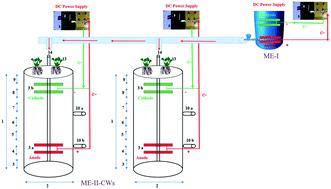当前位置:
X-MOL 学术
›
Environ. Sci.: Water Res. Technol.
›
论文详情
Our official English website, www.x-mol.net, welcomes your
feedback! (Note: you will need to create a separate account there.)
Installation of a bioelectrochemical system as a pre-cleaner in a constructed wetland with higher pollutant loading under continuous mode
Environmental Science: Water Research & Technology ( IF 3.5 ) Pub Date : 2020-10-21 , DOI: 10.1039/d0ew00621a Manoj Kumar 1, 2, 3, 4 , Rajesh Singh 1, 2, 3, 4
Environmental Science: Water Research & Technology ( IF 3.5 ) Pub Date : 2020-10-21 , DOI: 10.1039/d0ew00621a Manoj Kumar 1, 2, 3, 4 , Rajesh Singh 1, 2, 3, 4
Affiliation

|
In this study, two-phase continuous vertical flow constructed wetlands were installed with a pre-cleaner bioelectrochemical system for the removal of NH4+-N (60.41–85.78%), NO3−-N (25.55–35.18%), TN (57.80–84.65%), TKN (37.24–70.08%), PO43−-P (38.89–63.40%), SO42− (49.53–76.06%), and COD (25.83–74.70%) from municipal wastewater. The non-attainment of breakthrough points for PO43−-P shows its efficient removal by the matrix as insoluble PO43−-P. The flux of the electron acceptor species was inverse to each other in the pre-cleaner bioelectrochemical system (ME-I) and the constructed wetland bioelectrochemical system (ME-II-CWs). The functionalities and the change in the morphology of the matrix were evaluated using FTIR and SEM-EDX analysis. Fine globular structures were observed in cavities and the smooth surface of the fresh iron scraps (ISs) changed to a rough surface. The peeling was evenly distributed on ISs' surface after wastewater treatment. The iron contents decreased in iron scraps' surface by 47.33%, while it was deposited in the activated carbon layer, as inferred from the increase in its level by 5.99%. The application of a higher applied potential enhanced the COD reduction efficiency of the ME-I system. The surface incorporation of O contents to 48.08% from 18.93% in the granular activated carbon improved its pollutant-capturing behavior. The results of the present study showing the combination of CWs with the bioelectrochemical system is a promising technological approach in terms of wastewater treatment.
中文翻译:

在人工湿地上以连续模式安装生物电化学系统作为预净化器,以增加污染物的负荷
在本研究中,安装了两相连续垂直流人工湿地,并配有预净化器生物电化学系统,用于去除NH 4 + -N(60.41-85.78%),NO 3 -- N(25.55-35.18%),TN (57.80–84.65%),TKN(37.24–70.08%),PO 4 3-- P(38.89–63.40%),SO 4 2-(49.53–76.06%)和COD(25.83–74.70%) 。未达到PO 4 3-- P的突破点显示了其作为不溶性PO 4 3--被基质有效去除的能力-P 电子受体种类的通量在清洁前的生物电化学系统(ME-I)和人工湿地生物电化学系统(ME-II-CWs)中彼此相反。使用FTIR和SEM-EDX分析评估基质的功能和形态变化。在空腔中观察到细小球状结构,新鲜铁屑(ISs)的光滑表面变为粗糙表面。废水处理后,剥落均匀地分布在IS的表面上。铁含量降低了5.99%,铁屑表面的铁含量降低了47.33%,而沉积在活性炭层中。更高的施加电势的应用提高了ME-I系统的COD降低效率。O的表面结合率从18提高到48.08%。93%的颗粒状活性炭改善了其污染物捕获性能。本研究的结果表明,化学废物与生物电化学系统的结合在废水处理方面是一种很有前途的技术方法。
更新日期:2020-11-03
中文翻译:

在人工湿地上以连续模式安装生物电化学系统作为预净化器,以增加污染物的负荷
在本研究中,安装了两相连续垂直流人工湿地,并配有预净化器生物电化学系统,用于去除NH 4 + -N(60.41-85.78%),NO 3 -- N(25.55-35.18%),TN (57.80–84.65%),TKN(37.24–70.08%),PO 4 3-- P(38.89–63.40%),SO 4 2-(49.53–76.06%)和COD(25.83–74.70%) 。未达到PO 4 3-- P的突破点显示了其作为不溶性PO 4 3--被基质有效去除的能力-P 电子受体种类的通量在清洁前的生物电化学系统(ME-I)和人工湿地生物电化学系统(ME-II-CWs)中彼此相反。使用FTIR和SEM-EDX分析评估基质的功能和形态变化。在空腔中观察到细小球状结构,新鲜铁屑(ISs)的光滑表面变为粗糙表面。废水处理后,剥落均匀地分布在IS的表面上。铁含量降低了5.99%,铁屑表面的铁含量降低了47.33%,而沉积在活性炭层中。更高的施加电势的应用提高了ME-I系统的COD降低效率。O的表面结合率从18提高到48.08%。93%的颗粒状活性炭改善了其污染物捕获性能。本研究的结果表明,化学废物与生物电化学系统的结合在废水处理方面是一种很有前途的技术方法。











































 京公网安备 11010802027423号
京公网安备 11010802027423号